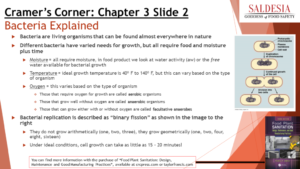Bacteria Explained


If you are working in a food manufacturing environment, you may be wondering if microorganisms might not only be introduced to the facility but whether they can survive and multiply. Bacteria may be simple, single-celled organisms but they have some of the same needs as more complex, multi-celled organisms like humans, for their metabolism. They require moisture, the have specific temperature requirements and they need nutrients to sustain life and grow. When you think about it, the typical food manufacturing facility offers the ideal environment for microorganisms and, given time, they can thrive and multiply.
The needs and growth of bacteria are explained briefly in the slide below and in greater detail in Chapter 3 of the book Food Plant Sanitation, entitled “Microorganisms of Food Manufacturing Concern”. Having this information can be beneficial to understanding the controls needed in your operation to prevent the harborage and growth of food spoilage or pathogenic organisms within your facility.”
Slide Content
Bacteria are living organisms that can be found almost everywhere in nature
Different bacteria have varied needs for growth, but all require food and moisture plus time
– Moisture = all require moisture, in food product we look at water activity (aw) or the free water available for bacterial growth
– Temperature = ideal growth temperature is 40⁰ F to 140⁰ F (4.4⁰ C to 60⁰ C), but this can vary based on the type of organism. For the most part freezing will not kill most microorganisms
– Oxygen = this varies based on the type of organism
– Those that require oxygen for growth are called aerobic organisms
– Those that grow well without oxygen are called anaerobic organisms
– Those that can grow either with or without oxygen are called facultative anaerobes
Bacterial replication is described as “binary fission” as shown in the image to the right
– They do not grow arithmetically (one, two, three…), they grow geometrically (one, two, four, eight, sixteen…)
– Under ideal conditions, cell growth can take as little as 15 – 20 minutes
– Think about that last point with regard to your plant environment and the importance of starting with a clean facility and maintaining sanitary conditions over the course of production
